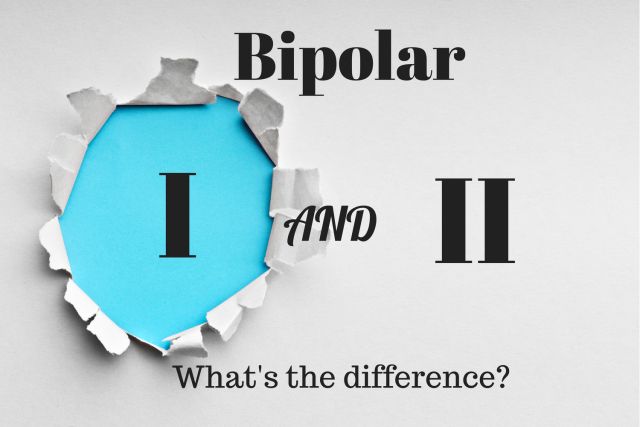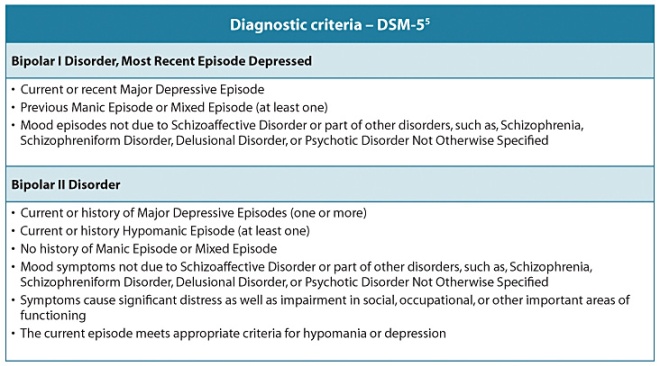There’s so much outdated information and misinformation out there about bipolar that either ignores or misinterprets the changes from DSM IV to 5 (bizarre to change the numbering system of the whole thing too, innit?). The difference between bipolars 1 and 2 is the thing I find most vague and variable online, so I looked at the diagnostic criteria first.
||source|| (well worth reading)
I always need to break stuff like that info right down.
My simple understanding of the differences between Bipolar 1 and 2 from the above is as follows:
Bipolar I: mania, possible mixed episodes,
Bipolar II: hypomania, no mania or mixed episodes.
And the commonalities:
Major Depression.
Mood symptoms not due to Schizoaffective Disorder, or part of other disorders such as Schizophrenia, Schizophreniform Disorder, Delusional Disorder, or Psychotic Disorder NOS.
The above helped me understand how and why I was diagnosed, as well as the reasons for the initial diagnosis being Bipolar II. I presented with Major Depression initially, as well as early signs of psychosis (low volume constant music auditory hallucinations). Once I’d worked out that I’d had previous psychosis stretching back to the late 90s at least, my psychiatrist updowngraded the diagnosis to Bipolar I. As the months went by, some more labels were slapped on. Rapid Cycling Bipolar I with Mixed and Psychotic Features.
Having received the first Bipolar II diagnosis while experiencing those early signs of psychosis, I was puzzled by all the info I found telling me that psychosis is a Bipolar I thing. So was early psychosis possible in Bipolar II, while full blown psychosis was Bipolar I, or what? Obviously I googled.
Part 1: Bipolar with Psychosis
Bipolar disorder is an illness that affects a person’s ability to regulate their moods. The two main mood swings are mania and depression and most people familiar with the illness have at least a basic understanding of these two symptoms. But when it comes to bipolar psychosis, knowledge can be limited and this very complex and very normal part of bipolar disorder is often underreported or missed until it’s too late. One reason for this is that there are still many people who don’t know that psychosis is common for people with Bipolar I (one) during manic and depressive episodes and is often present in Bipolar II (two) depression as well. But the main problem is that the general public has such a distorted view of bipolar psychosis, it’s difficult to find real and helpful information regarding this fascinating and often very destructive symptom of bipolar disorder.
||source||
For those who desire the srs bsns side of it, this is for you.
But there’s a ton of info that says that psychosis is only present in Bipolar I, so wtf is the reality? I googled for results within the past year and found more precise explanations, which confirmed and expanded upon the above. For example (there are many more) …
Psychotic symptoms are often present in the mania of Bipolar I disorder. The symptoms can also occur during depression and in many other disorders. The presence of psychosis automatically rules out a diagnosis of hypomania. Thus, people with both Bipolar 1 and Bipolar 2 can experience psychosis, but in Bipolar 2 they only appear during depressive episodes.
||source||
*Oprah voice* Eeeeeeeverybody’s getting psychosis!!!
(O joy, o rapture etc.)
Anyway, I thought I’d hunt down another sensible analysis of it all. One site did well until it included Bipolar NOS, which was one of the changes, there were other sites that did far better, but I thought a more academic approach might be the way to go, so here’s what the International Journal of Bipolar Disorders has to say, and it’s by a Swiss dude with the best name for his field ever – click the link for the full article. One thing I like about it, is that it points out some shortfalls in the Disturbing Specifications Manual.
From Bipolar disorders in DSM-5: strengths, problems and perspectives, by Jules Angst.
The main lines of the DSM-5 definition of major depressive episodes (MDE), basic to the diagnoses of both bipolar I and bipolar II disorders, are similar to those of DSM-IV: presence of five of nine diagnostic symptoms with a minimum duration of 2 weeks and a change from previous functioning. However, it is now possible to specify both depressive disorders and bipolar disorders with mixed features.
The definition of both manic and hypomanic episodes have been radically revised, which will impact on both bipolar diagnoses. The main changes are three: (1) a problematic change concerning the gate questions (criterion A), (2) a welcome reduction in the number of exclusion criteria and (3) a vigorous effort to operationalize bipolar subthreshold syndromes, hitherto unified under the NOS heading.
Gate questions for mania and hypomania
Where DSM-IV required, as criterion A, the presence of one of the two mood symptoms (elation/euphoric or irritable mood), in DSM-5, ‘the mood change must be accompanied by persistently increased activity or energy levels’. This new rule is, of course, more restrictive and excludes all individuals who report only one of the three entry symptoms and those with both elated and irritable mood. Thus, for no apparent reason, DSM-5 classifies some patients as having subthreshold bipolar disorders who would formerly have been diagnosed with manic episodes or bipolar I or II disorders. This strict new rule is not based on data, indeed it contradicts available evidence. As the international Bridge Study of 5,635 patients seeking treatment for major depressive episodes demonstrated clearly, any of those three gate questions is valid on its own, according to the criteria established by Robins and Guze (1970) and Angst et al. (2012).
Exclusion criteria
One important and amply justified change in DSM-5 concerns the diagnosis of bipolar II disorder. In DSM-IV, the change of major depression into hypomania under antidepressant treatments (ADs) was in principle an exclusion criterion. In DSM-5, that change – provided it persists at fully syndromal level beyond the physiological effect of the treatment – is explicitly a criterion for bipolar II disorder. DSM-5, like DSM-IV, allows some scope for clinical judgment as to causality. In addition, DSM-5 provides new formal criteria for substance/medication-induced bipolar and related disorder.
On the basis of the Bridge Study data (Angst et al. 2012), we can estimate that DSM-5 bipolar II disorder will be diagnosed about twice as often as heretofore and have a prevalence approaching that of bipolar I.
A more frequent diagnosis of bipolar II disorder is both justified and logical: a milder condition (in this case hypomania) is usually more prevalent than a severe one (mania). Over the long-term course of their illness, bipolar patients spend much more time in milder conditions, mainly minor depression, than in major syndromes (Phillips and Kupfer 2013).
Two exclusion criteria survive in DSM-5, namely ‘substance/medication-induced bipolar and related disorder’ and ‘bipolar and related disorder due to another medical condition’. Both clearly rely on questionable causal attributions based on partial co-occurrence with substance or medication use or full co-occurrence with another medical condition.
Other specified bipolar and related disorder (DSM-5)
DSM-5 has fortunately replaced DSM-IV’s vague group NOS by defining MDE with several subthreshold conditions of bipolarity, for instance, allowing a duration of 2 to 3 days for hypomanic episodes, as suggested by child psychiatrists, or fewer than four symptoms of hypomania during 4 days, or, for cyclothymia, specifying shorter manifestations (more than 24 months). A further important step is the recognition that dysthymia can co-occur with hypomania which is considered as a co-morbid condition, but why – one might ask – is it not allocated to cyclothymic disorder?





I’ve been looking for information about psychosis relating to the bipolar because I wanted some really colloquial explanations.
Like “psychosis is when you think you’re at a party but you’re not but you are and aren’t” which I read somewhere and I wasn’t sure if that was correct or just the consequence of the drugs they admitted to abusing.
I continue the search, starting from here. At the end of all this I think we may be better informed than shrinks. I still think no one has a damn clue, but today is denial day. I’ve learned to say no in 12 languages tonight.
LikeLiked by 5 people
Psychosis is fascinating. If you come across stuff about culture bound psychosis, please drop me the links, in case I haven’t already found them. “psychosis is when you’re at a party that isn’t there” would make more sense to me – “but you are and arent” just does my head in. Too much like heyyy maaaaan stoned hippie talk. What’s the denial stuff all about?
LikeLiked by 2 people
Working stuff through therapy made me realize my true feelings about certain things which I think my mind is just not ready to accept yet.
Will share links if I find.
LikeLiked by 1 person
I look forward to anything you may find & share! Great research Zoe!
LikeLiked by 2 people
I agree with Zoe – I think no one really has a clue, including the shrinks. Mine certainly doesn’t and I’m better informed than mine about what I need and how to handle my bipolar. Being queer and bipolar puts me in a category that he is not equipped to deal with so he just nods his head a lot. At least I get my meds!
LikeLiked by 2 people
None of the professionals I see about bipolar bat an eyelid about me being queer. Thank fuck..
LikeLiked by 2 people
= “professional” I’m confused about why a professional wouldn’t know how to deal with any client of any “category,” unless they’re not.
LikeLiked by 1 person
Many professionals don’t know how to deal with queer people. Governments, police….
LikeLike
Great (somewhat confusing info) Great post!! Thank ya. However,,, I wasn’t (in the audience) on the Oprah show ~ so do I have a chance to enter & win BIPOLAR here at home?! Lol! :)
LikeLiked by 1 person
(sorry, enter & win) PSYCHOSIS along with my bipolar,,,
LikeLiked by 1 person
But wait! There’s more! Call now to purchase BIPOLAR™ and get PSYCHOSIS™ free, yes 🆓 with every order. Hurry… Etc etc.
LikeLiked by 2 people
WOW!! I gotta tell my (hallucinated) friends!!!
LikeLiked by 1 person
Bargain! But does it make thousands of Julienne fries? Like the Ronco “Kitchen Magician” of my long lost youth?
LikeLiked by 1 person
It certainly will make thousands of julienne fries out of your long lost youth *wink and artifical glint on one tooth of my crocodile smile*
LikeLike
Tell me how I can lessen the confusion in future stuff? And yes of course, we’d never forget the viewers at home. Dial 0800-BIPOLAR
LikeLiked by 2 people
You can’t lessen things, it’s not YOU you’re good! :) it’s the medical community (DSM,,,(
LikeLiked by 1 person
Destructive Shit Manual. :D
LikeLiked by 2 people
}: ]
LikeLiked by 1 person
Good as a doorstop, though. (Apologies for randomness, but 1) it’s late, and 2) the UK doesn’t seem to distinguish between Bipolar 1 & II. Or, it didn’t when I was diagnosed. My husband has told me which category he thinks the DSM would put me in, but I keep forgetting.)
LikeLiked by 1 person
I think the initial Disaster Spirals Manual makes the initial distinction clearly (if you have full blown mania, it’s bipolar 1), but then it and everyone after it proceed to cloud the air with the wanky jargon of physicians with God complexes and then zzzzzzzzzz who cares anyway…
LikeLike
Sorry I’m really scatter brained/med head!? (more than normal) thank you to both Blahpolar & Zoe for your interesting educational insightful info!!!
LikeLiked by 1 person
This shit makes my head hurt. I still like “fucked up due to faulty wiring.” Concise. Seriously, the DSM has become a clusterfuck of a joke. If you have have A, B, C but they only last X amount of time, then you can’t be this, but you also can’t be that,. and…
I need to go drink some Jim Jones Kool-Aid now. Diane’s serving today.
LikeLiked by 1 person
Ja it all turns into algebra. Can’t understand the disorder, it’s no wonder the meds are a fuckapalooza too.
LikeLiked by 1 person
This made my head spin…not because of your writing, but because it was a reminder of all the bevy of bipolar information that applies, kinda applies and simply does not apply at all. I was diagnose as bipolar 2, but apparently bipolar 1 has mixed states (didnt know that) and 2 has psychosis (didn’t know that either)? Go figure. Sigh.
LikeLiked by 1 person
And the DSM is as flawed as fuck… Idk how the different categories help anyway. It’s not like each type has one effective treatment regime. Ha. Ha. Not very ha.
LikeLiked by 1 person
I got diagnosed in a country where I didn’t speak the language. Although excellent their English is, so much is lost in translation. I still don’t really have a clue much about the differences and a good understanding of what it is and it’s hard to ask the right questions when so often I get misunderstood or have to have the information through a third party. This is a really helpful article thank you.
LikeLiked by 1 person
Eek that must be tough – and you are very welcome indeed.
LikeLike